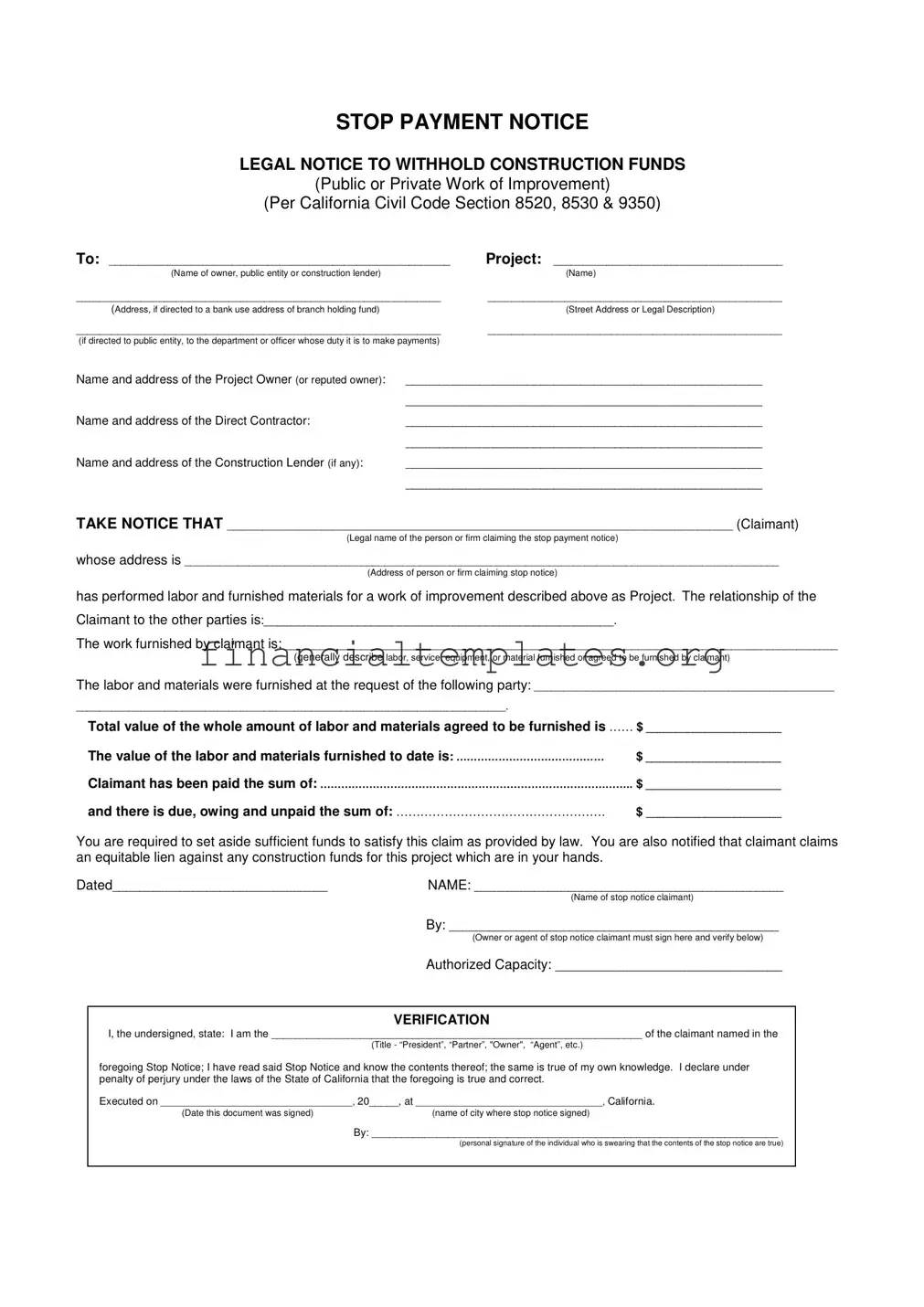STOP PAYMENT NOTICE
LEGAL NOTICE TO WITHHOLD CONSTRUCTION FUNDS
(Public or Private Work of Improvement)
(Per California Civil Code Section 8520, 8530 & 9350)
To: __________________________________________________________ |
Project: _______________________________________ |
(Name of owner, public entity or construction lender) |
|
(Name) |
______________________________________________________________ |
__________________________________________________ |
(Address, if directed to a bank use address of branch holding fund) |
|
(Street Address or Legal Description) |
______________________________________________________________ |
__________________________________________________ |
(if directed to public entity, to the department or officer whose duty it is to make payments) |
|
Name and address of the Project Owner (or reputed owner): |
_____________________________________________________ |
|
_____________________________________________________ |
Name and address of the Direct Contractor: |
_____________________________________________________ |
|
_____________________________________________________ |
Name and address of the Construction Lender (if any): |
_____________________________________________________ |
|
_____________________________________________________ |
TAKE NOTICE THAT ______________________________________________________________________________________ (Claimant)
(Legal name of the person or firm claiming the stop payment notice)
whose address is _____________________________________________________________________________________________________
(Address of person or firm claiming stop notice)
has performed labor and furnished materials for a work of improvement described above as Project. The relationship of the Claimant to the other parties is:____________________________________________________.
The work furnished by claimant is: ______________________________________________________________________________________________
(generally describe labor, service, equipment, or material furnished or agreed to be furnished by claimant)
The labor and materials were furnished at the request of the following party: ___________________________________________________
_________________________________________________________________________.
Total value of the whole amount of labor and materials agreed to be furnished is …… $ _______________________
The value of the labor and materials furnished to date is: …………………………………… $ _______________________
Claimant has been paid the sum of: …………………………………………………………………………….. $ _______________________
and there is due, owing and unpaid the sum of: ……………………………………………. $ _______________________
You are required to set aside sufficient funds to satisfy this claim as provided by law. You are also notified that claimant claims an equitable lien against any construction funds for this project which are in your hands.
Dated________________________________ |
NAME: ______________________________________________ |
|
|
(Name of stop notice claimant) |
|
|
By: _________________________________________________ |
|
|
(Owner or agent of stop notice claimant must sign here and verify below) |
|
|
Authorized Capacity: ______________________________ |
|
|
|
|
|
VERIFICATION |
|
I, the undersigned, state: I am the _______________________________________________________________ of the claimant named in the |
|
|
(Title - “President”, “Partner”, "Owner", “Agent”, etc.) |
foregoing Stop Notice; I have read said Stop Notice and know the contents thereof; the same is true of my own knowledge. I declare under penalty of perjury under the laws of the State of California that the foregoing is true and correct.
Executed on ______________________________________, 20_____, at _____________________________________, California.
(Date this document was signed)(name of city where stop notice signed)
By: _____________________________________________________________________
(personal signature of the individual who is swearing that the contents of the stop notice are true)
REQUEST FOR NOTICE OF ELECTION
(Private Works Only)
(Per California Civil Code Section 8536 & 8538)
If an election is made not to withhold funds pursuant to this stop notice by reason of a payment bond having been recorded, please send notice of such election and a copy of the bond within 30 days of such election in the enclosed preaddressed stamped envelope. This information must be provided by you under Civil Code Sections 8536 & 8538.
Signed: ____________________________________________________________________________________________
(Claimant must enclose self-addressed stamped envelope)
PROOF OF NOTICE DECLARATION
(Per California Civil Code Section 8118)
I, ____________________________________________, declare that I served a copy of the Stop Payment Notice on the party at the address
and on the date shown below:
To Construction Lender/Owner/Public Entity/Or Other Person Holding Construction Funds: (name) _________________________________________________________________
(title or capacity of individual given notice) ____________________________________
(address) _________________________________________________________________________________________
(date)__________________________________________
Stop Payment Notice should be served at the following location:
(a)To an owner other than a public entity, the owner’s address shown on the direct contract, the building permit or a construction trust deed;
(b)To a public entity, the office of the public entity or another address specified by the public entity in the contract or elsewhere for service of notices, papers or other documents. A Stop Payment Notice for a public works contract of the state, shall be given to the director of the department that awarded the contract; and to a public entity other than the state, to the office of the controller, auditor or other public disbursing officer whose duty it is to make payment pursuant to the contract (see Civil Code §9354 for more information).
(c)To a direct contractor, at the contractor’s address shown on the building permit, on the direct contract, or on the records of the Contractors’ State License Board.
In the following manner (check appropriate box):
[ ] By personal delivery
[ ] By Registered or Certified Mail (postage prepaid)
[ ] Express mail
[ ] Overnight delivery by ___________________________________, an express service carrier
I declare under penalty of perjury, that the foregoing is true and correct. Executed on _______________________, at
_____________________, California.
_______________________________________
(Signature of person making service)
C&B Forms (7/12)


